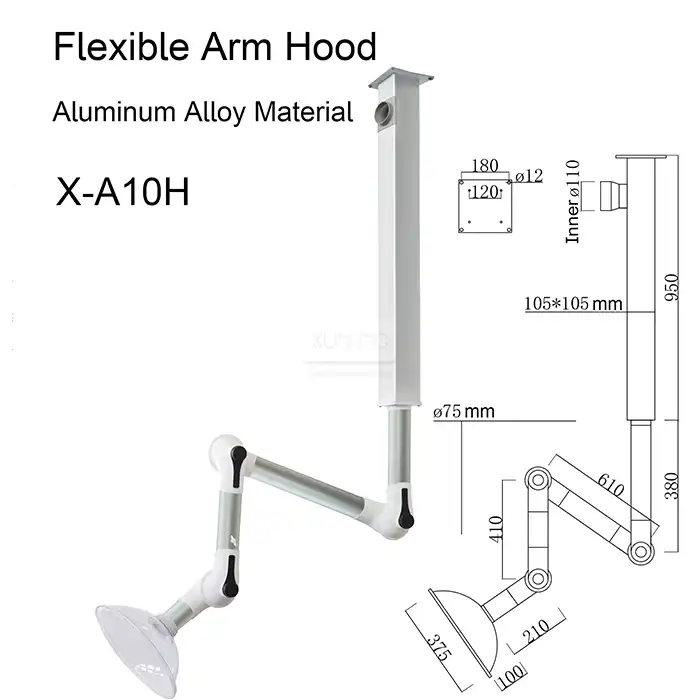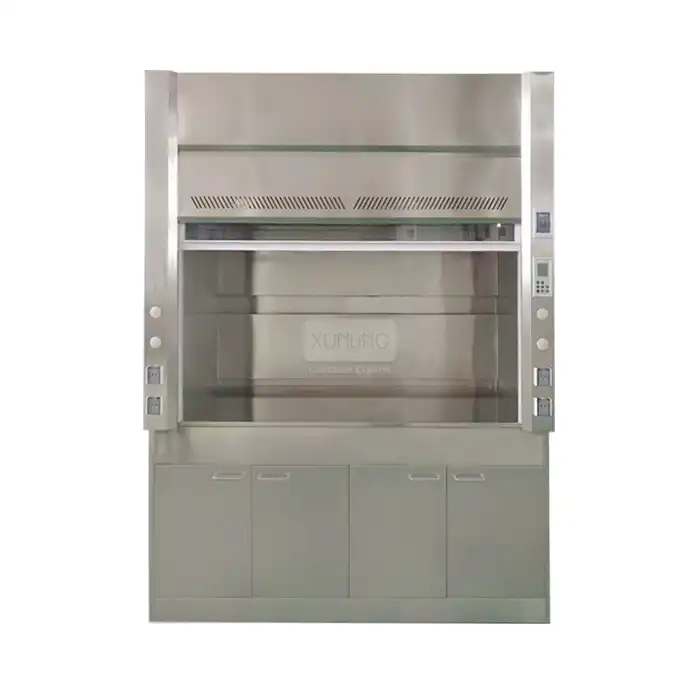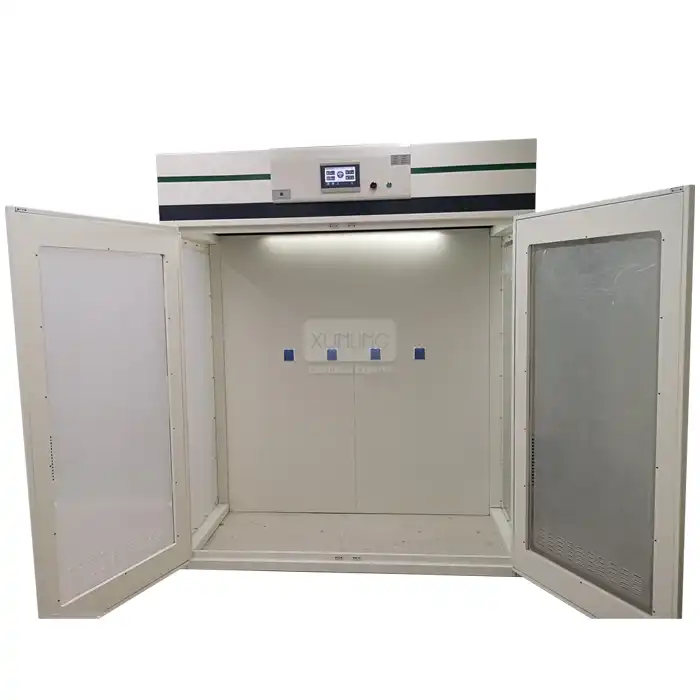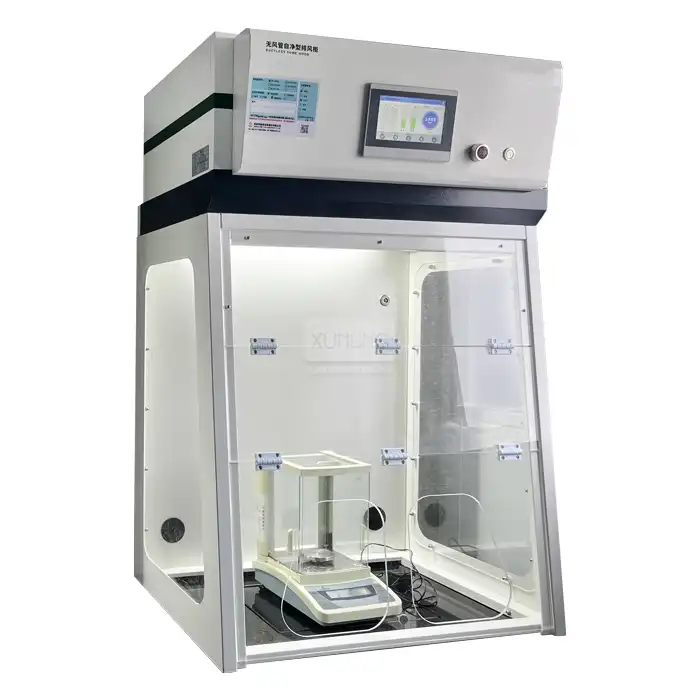
Self Contained Fume Hood: The Secret to Efficient Laboratory Design
2025-10-01 09:00:02
In the rapidly evolving world of laboratory safety and design, Self Contained Fume Hood systems have emerged as revolutionary solutions that transform how laboratories approach hazardous material handling. These innovative devices represent the perfect fusion of safety, efficiency, and practical design, offering laboratories unprecedented flexibility without compromising on protection standards. Unlike traditional ducted systems that require extensive infrastructure modifications, Self Contained Fume Hood units operate independently, capturing, filtering, and recirculating air through advanced filtration systems. This technological advancement has made them indispensable for modern laboratory environments seeking optimal performance, cost-effectiveness, and adaptability in their safety protocols.
Why Self Contained Fume Hoods Are Essential for Modern Laboratory Safety?
Advanced Safety Features That Protect Your Personnel
Modern Self Contained Fume Hood systems incorporate multiple layers of protection that go far beyond traditional ventilation methods. These units utilize sophisticated filtration technologies, including pre-filters, HEPA filters, and activated carbon systems that work synergistically to capture various types of contaminants. The filtration process begins with pre-filters that remove larger particles and dust, followed by HEPA filters that eliminate microscopic particulates with 99.97% efficiency for particles as small as 0.3 microns. The activated carbon stage then absorbs volatile organic compounds, chemical vapors, and odorous substances. Real-time monitoring systems continuously assess air quality and filtration performance, providing immediate alerts when filter replacement becomes necessary. The containment design ensures that hazardous fumes, vapors, and particles remain trapped within the hood's working area, with airflow velocities typically maintained between 0.3-0.7 m/s to ensure optimal capture efficiency. Emergency shutdown features and fail-safe mechanisms provide additional layers of protection, automatically activating when system anomalies are detected. LED lighting systems illuminate the work surface effectively while consuming minimal energy, and noise levels are kept below 52 dBA to maintain a comfortable working environment.
Cost-Effective Installation and Maintenance Solutions
The economic advantages of Self Contained Fume Hood systems extend far beyond their initial purchase price. Traditional Ducted Fume Hoods require extensive HVAC modifications, including ductwork installation, makeup air systems, and building infrastructure changes that can cost thousands of dollars per unit. In contrast, self-contained units require only electrical connection and can be operational within hours of delivery. This plug-and-play functionality eliminates construction delays, minimizes facility downtime, and reduces installation costs by up to 70% compared to traditional systems. Maintenance requirements are streamlined through user-friendly filter replacement procedures that don't require specialized technicians or system shutdowns. The modular filter design allows for selective replacement of individual filtration stages based on usage patterns and contamination types. Energy consumption is significantly lower than ducted systems because there's no need for heated or cooled makeup air, resulting in substantial utility cost savings. The LCD display control systems provide clear maintenance schedules and filter life indicators, enabling proactive maintenance planning that prevents unexpected downtime and extends equipment lifespan.
Flexibility and Mobility for Dynamic Laboratory Environments
Laboratory requirements frequently evolve due to research focus changes, space reconfigurations, or equipment upgrades. Self Contained Fume Hood systems excel in these dynamic environments due to their inherent mobility and adaptability. Unlike permanent ducted installations, these units can be relocated within facilities without infrastructure modifications or service interruptions. This flexibility proves invaluable for educational institutions where laboratory layouts change seasonally, research facilities conducting varied experiments, and commercial laboratories adapting to new analytical methods. The benchtop models can be positioned on existing work surfaces, while base cabinet configurations provide additional storage while maintaining mobility. Custom sizing options accommodate specific space constraints and workflow requirements, with external dimensions ranging from 800mm to 1600mm in width to suit various laboratory configurations. The self-contained design allows laboratories to establish fume hood capacity exactly where needed, eliminating the compromise between optimal positioning and available ductwork locations. This positioning flexibility often results in improved workflow efficiency and reduced personnel exposure risks.
Technical Specifications That Define Superior Performance
Filtration Systems and Contamination Control
The heart of any Self Contained Fume Hood lies in its filtration system, which determines both safety performance and operational efficiency. Modern systems employ three-stage filtration processes specifically engineered to address diverse laboratory contaminants. The primary pre-filtration stage captures larger particles, protecting downstream filters and extending their operational life. These pre-filters typically feature pleated designs with high dust-holding capacity and can be easily accessed for replacement without system shutdown. HEPA filtration represents the secondary stage, utilizing true HEPA media that meets stringent efficiency standards for submicron particle removal. These filters are crucial for applications involving biological agents, fine powders, and microscopic contaminants. The tertiary activated carbon stage addresses gaseous contaminants through adsorption mechanisms that neutralize volatile organic compounds, acid vapors, alkaline fumes, formaldehyde, ammonia, and organic solvents. Carbon filter configurations can be customized based on specific chemical applications, with specialized formulations available for mercury vapor, formaldehyde, or specific organic compound families. Some advanced systems incorporate additional specialized media for targeted contaminant removal, such as permanganate-impregnated carbon for specific organic compounds or specialized sorbents for inorganic acids.
Airflow Engineering and Performance Monitoring
Proper airflow management distinguishes professional-grade Self Contained Fume Hood systems from basic filtration units. Advanced computational fluid dynamics modeling ensures optimal air capture patterns within the hood's working area, preventing contaminant escape while maintaining user comfort. The airflow system must balance capture velocity, face velocity uniformity, and energy efficiency to provide reliable protection. Adjustable airflow controls allow operators to optimize performance for specific applications, with velocity ranges typically spanning 0.3 to 0.7 m/s at the hood face. Real-time airflow monitoring systems continuously measure and display current performance parameters, providing immediate feedback on system status. Digital displays show face velocity, filter loading, and operational hours, enabling data-driven maintenance decisions. Some systems incorporate wireless connectivity for remote monitoring and data logging, facilitating compliance documentation and preventive maintenance scheduling. Alarm systems alert operators to conditions requiring attention, such as low airflow, filter saturation, or system malfunctions. The monitoring technology ensures consistent performance throughout filter life cycles, maintaining protection standards even as filters approach replacement intervals.
Control Systems and User Interface Design
Modern Self Contained Fume Hood systems feature sophisticated control systems that prioritize both safety and operational simplicity. LCD display interfaces provide clear, intuitive access to all system functions while displaying critical performance data in real-time. These displays typically show airflow velocity, filter status indicators, operational hours, and alarm conditions through easy-to-understand graphics and numerical displays. User controls are ergonomically positioned for convenient access without interfering with work activities. Memory functions store operational parameters and maintenance records, supporting quality assurance programs and regulatory compliance requirements. Some advanced systems incorporate programmable operation modes that automatically adjust performance parameters based on scheduled activities or detected chemical types. Integration capabilities allow connection with laboratory management systems for centralized monitoring and control. Safety interlocks prevent operation when critical parameters fall outside acceptable ranges, automatically shutting down systems when necessary to prevent exposure risks. The control systems often include password protection for critical settings, ensuring that safety parameters cannot be inadvertently modified by unauthorized personnel. Diagnostic routines provide troubleshooting guidance and maintenance reminders, reducing downtime and ensuring optimal performance throughout the equipment lifecycle.
Applications and Industry Implementation Strategies
Research and Development Laboratory Applications
Self Contained Fume Hood systems have revolutionized research and development laboratory operations across multiple scientific disciplines. In pharmaceutical research facilities, these systems provide essential protection during drug discovery processes involving potent compounds, volatile solvents, and experimental formulations. The ability to handle multiple chemical types through customizable filtration configurations makes them ideal for synthetic chemistry applications where reaction byproducts and reagent vapors must be controlled. Analytical chemistry laboratories benefit from the containment capabilities when processing samples that may generate hazardous vapors during preparation or analysis procedures. The compact footprint and mobility features prove particularly valuable in research environments where experimental setups frequently change and equipment must be reconfigured for different studies. Universities and academic institutions utilize these systems in teaching laboratories where student safety is paramount, and the simplified operation reduces training requirements while maintaining high protection standards. Biotechnology companies appreciate the biological safety capabilities provided by HEPA filtration stages, which protect both personnel and products from cross-contamination. Contract research organizations value the flexibility to rapidly establish containment capabilities for new client projects without infrastructure investments.
Industrial and Quality Control Applications
Manufacturing facilities and quality control laboratories rely on Self Contained Fume Hood systems for protecting personnel during routine testing and analysis procedures. Pharmaceutical manufacturing operations use these systems during raw material testing, in-process monitoring, and finished product analysis where exposure to active pharmaceutical ingredients must be minimized. Chemical manufacturing facilities implement these systems for sample preparation, quality testing, and small-scale process development activities. Environmental monitoring laboratories depend on reliable containment during sample processing and analysis of potentially hazardous environmental samples. Food and beverage industry applications include flavor analysis, additive testing, and contamination assessment procedures where vapors and particles must be controlled. Petrochemical industry laboratories utilize these systems for hydrocarbon analysis, fuel testing, and additive evaluation procedures. Electronics manufacturing facilities employ them for cleaning solution handling, flux processing, and quality control testing of components exposed to various chemicals. The consistent performance and reliability of Self Contained Fume Hood systems support continuous operations in these industrial settings where productivity and safety must be balanced effectively.
Healthcare and Clinical Laboratory Integration
Healthcare facilities and clinical laboratories require specialized containment solutions that address unique operational challenges and regulatory requirements. Hospital laboratories utilize Self Contained Fume Hood systems for specimen preparation, chemical analysis, and reagent handling procedures where healthcare worker safety is critical. The quiet operation characteristics prove especially important in healthcare environments where noise levels must be minimized. Pathology laboratories benefit from the biological containment capabilities when processing specimens that may contain infectious agents or require chemical fixation procedures. Clinical chemistry laboratories rely on these systems during automated analyzer maintenance, calibration procedures, and quality control activities involving hazardous reagents. Veterinary clinics and research facilities appreciate the flexibility to establish containment capabilities in diverse locations without major facility modifications. Blood banks and transfusion services utilize these systems for testing procedures and reagent preparation activities. Microbiology laboratories implement them for media preparation and specimen processing activities where both chemical and biological hazards may be present. The combination of HEPA and activated carbon filtration provides comprehensive protection for the diverse contaminant types encountered in healthcare laboratory applications.
Conclusion
Self Contained Fume Hood systems represent the future of laboratory safety technology, offering unparalleled flexibility, cost-effectiveness, and performance for modern laboratory environments. These innovative solutions eliminate traditional barriers to implementing proper containment while providing superior protection through advanced filtration technologies. The combination of easy installation, minimal maintenance requirements, and exceptional containment capabilities makes them essential tools for laboratories seeking to enhance safety protocols without compromising operational efficiency or budget constraints.
Xi'an Xunling Electronic Technology Co., Ltd. stands at the forefront of this technological revolution, delivering cutting-edge Self Contained Fume Hood solutions that exceed international safety standards. With over a decade of manufacturing expertise, advanced production facilities, and comprehensive quality control processes, we ensure every unit meets the highest performance and safety requirements. Our commitment extends beyond product delivery through comprehensive after-sales support, customization options, and technical expertise that empowers laboratories worldwide to achieve their safety and operational objectives.
Are you ready to transform your laboratory's safety and efficiency? As a leading China Self Contained Fume Hood factory, China Self Contained Fume Hood supplier, and China Self Contained Fume Hood manufacturer, we offer comprehensive China Self Contained Fume Hood wholesale solutions tailored to your specific requirements. Our Self Contained Fume Hood for sale options include competitive Self Contained Fume Hood price points without compromising on High Quality Self Contained Fume Hood standards. Experience the advantage of partnering with a trusted manufacturer that combines advanced technology, proven reliability, and exceptional value. Our 5-day delivery guarantee, 5-year warranty coverage, custom manufacturing capabilities, and one-stop service approach ensure your complete satisfaction. Take the next step toward enhanced laboratory safety and efficiency by contacting our expert team at xalabfurniture@163.com for detailed specifications, customization options, and competitive pricing information.
References
1. "Laboratory Ventilation Standards and Guidelines for Fume Hood Performance" - American Society of Heating, Refrigerating and Air-Conditioning Engineers (ASHRAE), ANSI/ASHRAE 110-2016
2. "Recommended Practices for Laboratory Fume Hoods" - Scientific Equipment and Furniture Association (SEFA), SEFA 1-2010 Standard
3. "Containment Equipment Selection Guide for Laboratory Chemical Fume Hoods" - National Institute for Occupational Safety and Health (NIOSH), Publication No. 2012-147
4. "Laboratory Safety and Chemical Hygiene Plan Guidelines" - Occupational Safety and Health Administration (OSHA), 29 CFR 1910.1450
YOU MAY LIKE







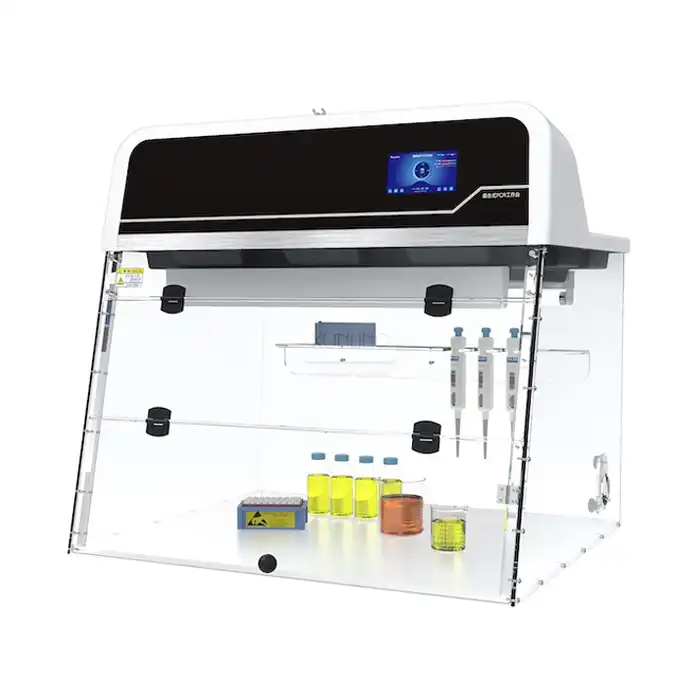
_1756093882793.jpg)

_1741664313364.webp)
